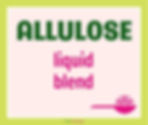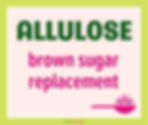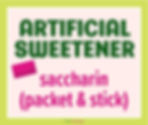ZERO CALORIE SWEETENER
2025 BUYING GUIDE
In my quest to help home cooks navigate the complex world of zero-calorie sweeteners in U.S. stores, I found thousands of options. To make sense of it all, I’ve created the ultimate guide, sorting every sweetener into two easy-to-navigate groups: natural and artificial.
WHAT DOES "ZERO-CALORIE" MEAN?
By law, a sweetener may be labeled calorie-free, no-calorie, or zero-calorie if it provides less than 5 calories per serving. One serving is usually the amount of product (teaspoon, drops, squeezes, packets) with sweetness equivalent to 1 or 2 teaspoons of table sugar.
Zero Calorie Sweeteners are available in various forms — granulated, powdered, sachet, cube, tablet, and liquid (drops and syrups). The color code for them tends to be:

WHAT'S A HIGH INTENSITY SWEETENER?
Most zero-calorie sugar substitutes you find in stores contain High-Intensity (HI) Sweeteners — either as the sole ingredient or in tiny amounts blended with other sweeteners. When pure, they deliver intense sweetness without calories, and no nutritional benefits.
Since they're several hundred times sweeter than table sugar, just a pinch goes a long way. At such small amounts, HI sweeteners don’t add volume or impact texture—they won’t thicken, bind, or make your recipe viscous.
Unlike table sugar, they are used mainly for sweetening purposes and no other culinary role.
That’s why they’re often blended with bulk sweeteners, which help them in four key ways:
-
give them an overall resemblance to table sugar
-
make them spoonable and pourable
-
mask their off-flavors
-
improve mouthfeel by adding weight and volume.
Pure high-intensity sweeteners (without any additives or fillers) work best in recipes that don't rely on sugar for texture, shelf life, moisture retention, color, or flavor.
NAVIGATING ZERO-CALORIE SWEETENERS
Here's a common misconception: all zero-calorie sweeteners are high-intensity.
But that’s not the case. Take erythritol and allulose — both can be labeled as zero-calorie, but they're not high-intensity. In fact, both are less sweet than table sugar. And unlike high-intensity sweeteners, they are not completely calorie-free. They provide about 1 to 1.5 calories per teaspoon or 40 to 70 calories per cup.
So, what do they have in common?
Whether it’s pure stevia or pure sucralose — which are incredibly sweet in tiny amounts — or erythritol and allulose, they all sweeten with little to no calories. But how they work, how much you need, and how they affect recipes can vary a lot.
Since most zero-calorie products in stores contain high-intensity (HI) sweeteners, we'll start by breaking them down.
Here's how we'll walk through them:
FDA-APPROVED HIGH-INTENSITY SWEETENERS
Ten high-intensity sweeteners are permitted for use in food in the US. When artificial, they're regulated as a food additive. When natural, they have their use as a sweetener generally recognized as safe (GRAS).
The key difference is that food additives undergo premarket review and approval by the U.S. Food and Drug Administration (FDA).
GRAS substances, on the other hand, have their safety evaluated by "experts qualified by scientific training and experience" — not by the FDA. In most cases, these experts are industry scientists, meaning companies often self-certify the ingredients they sell as safe. That said, it's not an easy process — the FDA still expects thorough toxicology studies, clearly defined safe use levels, and does an in depth review of all the supporting scientific evidence.
‘Nutritive’ Sweeteners [But Don’t Add Calories]
Among all high-intensity sweeteners, three — aspartame, thaumatin, and brazzein — are technically nutritive because they’re proteins and provide 4 calories per gram. But since they’re used in such tiny amounts, due to their intense sweetness, they don’t contribute meaningful calories. So, they're effectively non-nutritive. Aspartame is 100 to 400 times sweeter than sugar, thaumatin ranges from 2000 to 5000, and brazzein 500 to 2,000.
Non-Nutritive Sweeteners
Stevia, monk fruit, sucralose, saccharin, acesulfame K, neotame, and advantame are non-nutritive sweeteners (0 cal/gram).
NATURAL & HIGH-INTENSITY
WHAT'S A NATURAL SWEETENER?
If you're wondering "What exactly is the difference between natural and artificial? — here's how the FDA views it.
Natural ingredients are those "found in nature". However, some of these substances exist in nature only in tiny amounts and must be "manufactured artificially" to be produced on a large scale. The FDA still considers these “natural” [but for clarity, here at WhatSugar we refer to them as synthetic].
To explain this, the FDA uses vitamin C (ascorbic acid) as an example. It can be derived from an orange or artificially produced via fermentation, but the final ingredient is identical. The same applies to synthetic sweeteners like erythritol and allulose, which exist in nature but are commercially produced from corn.
On the other hand, the FDA defines artificial ingredients as those "not found in nature and therefore must be artificially produced". So, in short: Both synthetic and artificial sweeteners are manufactured artificially ("yeast/enzyme made" vs "human made"), but synthetic ones exist in nature, while artificial ones do not.
Note that synthetic is not the same as artificial. Vitamin C made via fermentation would not be considered artificial as it’s indistinguishable from the vitamin C found naturally in fruits. Learn more about natural vs artificial HERE and HERE.
Which high-intensity sweeteners are FDA-approved as natural?
Natural sweeteners are directly extracted from plants. The FDA has permitted the use of four natural sweeteners, as GRAS substances:
-
Stevia
As of March 2025, stevia (leaf extract) holds the title of the most popular high-intensity sweetener. As I explain in my Guide to Buying Stevia, products can contain a blend of different steviol glycosides (the sweet compounds of the stevia leaf) or just some of them, like reb A or stevioside. Pure stevia extracts are 50 to 450x sweeter than sugar.
-
Monk Fruit
While stevia has been used as a sweetener for many years and is widely accessible, monk fruit is relatively new and may not be as readily available in all stores. Monk fruit is also more expensive than stevia and appeals to those that do not like the taste of stevia. Pure monk fruit extracts are 100 to 250x sweeter than sugar.
-
Thaumatin
Thaumatin comes from a mixture of proteins isolated from the katemfe fruit of West Africa. It's the sweetest natural substance known to man — yet it’s rarely used just for sweetness. Instead, it’s valued for its unique flavor-modifying properties, which work at extremely low concentrations. Pure thaumatin is 2000 to 3000x sweeter than sugar.
-
Brazzein
The newcomer, approved in 2024, brazzein is a sweet protein from a West African fruit. It’s still new to the market and not yet widely available to home cooks, but food companies are beginning to use it in beverages, chocolate, and other low-sugar treats. Brazzein is over 500x sweeter than sugar.
Explore products with natural, high-intensity sweeteners below:
ARTIFICIAL & HIGH-INTENSITY
WHAT'S AN ARTIFICIAL SWEETENER?
Artificial sweeteners are entirely man-made and do not exist in nature. Even if produced from a source material found in nature OR if their component parts are common in nature, it does not make them a natural sweetener. For instance, sucralose is made from table sugar. Aspartame is split in our bodies into 3 components widely found in foods such as meats, fish, dairy products, eggs, nuts, fruits, and vegetables.
Which high-intensity sweeteners are FDA-approved as artificial?
The FDA has permitted the use of six artificial sweeteners, as food additives:
-
Sucralose
The most widely used today found in the Splenda yellow packets (Splenda also offers stevia, monk fruit, and allulose sweeteners with no sucralose). Pure sucralose is about 600x sweeter than sugar.
-
Aspartame
The only nutritive sweetener because, being a protein, it provides 4 calories per gram, but it’s used in such tiny amounts that it’s effectively non-nutritive (calorie-free). Pure aspartame is around 200x sweeter than sugar.
-
Acesulfame potassium (ace-K)
The blend aspartame-acesulfame works well to create a more sugar-like taste profile. Pure ace-k is around 200x sweeter than sugar.
-
Saccharin
The first artificial sweetener sold in stores, known for its popular brand Sweet’N Low. Pure saccharin is 200 to 700x sweeter than sugar.
-
Neotame
A newer sweetener but is rarely used in consumer products. Neotame is 7,000 to 13,000x sweeter than sugar.
-
Advantame
The most recently approved but not commonly found in sugar substitutes. Advantame is about 20,000x sweeter than sugar.
Explore artificial products by clicking below:
ARE SWEETENERS SAFE?
Are sweeteners worse than sugar? What's the safest sweetener to use? These are questions that come up often—and for good reason with the sea of information out there. So here's what you need to know.
By law, all sweeteners sold in stores must be safe for consumption. You can read how the FDA assesses their safety HERE.
All ten FDA-approved high-intensity sweeteners (HIS) are over a hundred times sweeter than table sugar, so we consume them in tiny amounts.
Based on scientific evidence, they're considered safe for the general population when consumed as intended. The FDA has determined that the estimated daily intake of HIS remains within safe limits, even for heavy users.
High-intensity sweeteners hasn’t been linked conclusively to any specific health problems. They do not cause cancer in humans at the levels we consume. They are safe for people with diabetes, children, and pregnant or breastfeeding women, plus they're non-cariogenic.
Three areas regarding the effects of high-intensity sweeteners need more research to fully understand their effects:
-
There's lack of evidence showing HI sweeteners are effective in helping people lose weight in the LONG TERM (over 6 to 18 months), even though studies have shown small weight loss in the short term (3 months or less). You can read the position of World Health Organization and the Dietary Guidelines for Americans on that.
-
Research on how HI sweeteners influence gut microbiome is conflicting. However, large projects like the American Gut Project emphasizes that gut microbiome diversity is strongly shaped by overall diet, especially the variety of plant foods consumed. While single ingredients (like sweeteners) might have effects, the project’s findings consistently show that broad dietary patterns — not isolated foods ingredients — have the biggest impact on gut health.
-
It's controversial whether consuming something sweet without calories — like between meals in liquid form, made with HI sweeteners — could influence appetite and food cravings. Think: a midday Coke Zero as a pick-me-up. Some studies suggest hunger may return quickly, and even stronger than before.
If you’re concerned about the HI sweeteners conflicting effects, remember that how you use them matters. So, keep reading to find the #1 rule to use sweeteners wisely.
SWEETENERS DONE RIGHT
Whether it’s sugar or a zero-calorie option, how you use sweeteners matters just as much as which one you choose.
The biggest mistake? Using sweeteners with foods that don’t keep you full. Zero-calorie sweeteners do nothing for satiety, and sugar does little. Without protein, fat, or fiber, hunger often returns quickly.
One of the worst ways to use sweeteners? On an empty stomach, between meals, in liquid form — like sodas, energy drinks, or sports drinks (diet or not).
The Golden Rule for Using Sweeteners
👉 Pair sweeteners — sugar or alternatives — with filling foods.
Combine them with whole foods, nutrient-dense options rich in protein, fat, or fiber — like milk, fruits, cream, peanut butter, or whole grains.
These foods do three important things:
✅ Keep you full
✅ Slow digestion
✅ Help your body release energy more steadily
Turns out, Mom was right: dessert is best after a balanced meal.
Want sweeteners to work for you—not against you?
Start by having them with real food. If you're drinking a soda, have it with a pack of nuts. Add sweeteners to your oats or yogurt. Like smoothies? Here's why they may not fill you up like whole foods do.
Why does food pairing matter so much with zero-calorie sweeteners?
Because science still has open questions — areas under research or debate (see section above). For example, studies have mixed findings on whether tasting sweetness without calories may boost appetite or cravings. Pairing sweeteners with satiating foods, helps you avoid those effects and supports healthier habits.
ASPARTAME UNDER THE MICROSCOPE
Aspartame is one of the most studied food additives in the human food supply, yet it remains the most controversial sweetener. Approved in more than 90 countries, Americans have been sweetening with it for nearly 50 years.
The latest controversy arose in July 2023, when the World Health Organization's cancer research arm (IARC) released a risk assessment of aspartame and cancer. They classified aspartame as a possible carcinogen in humans, specifically liver cancer because there are some studies in humans that suggest a "possible" link between the substance and cancer, but the data isn’t strong or consistent enough to say it does cause cancer. WHO flagged a “possible” link, based on limited evidence—not that a risk has been confirmed.
However, WHO’s food safety arm (JECFA), along with the European Food Safety Authority (EFSA), the FDA, and other leading health agencies, reviewed the same data and confirmed that aspartame remains safe when consumed within the established limits.
Here's the FDA statement: "The FDA disagrees with IARC’s conclusion that the studies support classifying aspartame as a possible carcinogen to humans. FDA scientists reviewed the scientific information included in IARC’s review in 2021 when it was first made available and identified significant shortcomings in the studies on which IARC relied."
The FDA emphasizes that the WHO did not raise safety concerns for aspartame at the current levels of use. In addition, WHO did not change the prior Acceptable Daily Intake (ADI) of aspartame of 40 mg/kg of body. WHO affirmed that an intake within this range is safe for a lifetime of daily use.
Wondering what exactly is the ADI?
ADI is the amount of a substance considered safe to consume every day over the course of a person's entire life. To understand what this limit means for aspartame, a 150-pound (68 kg) person would need to consume a total of 75 packets per day of Equal, every single day of their entire lifetime.
To read what the American Cancer Society has to say about that, go HERE.
If you’re feeling overwhelmed by the sea of information about sweeteners safety, I’ve created a resource to help you make sense of it all. [Access it here.]
"ZERO" CALORIE COUNT
HOW MANY CALORIES ARE IN SWEETENERS?
I often get questions about counting calories in food products with sweet carbohydrates—erythritol, allulose, maltodextrin, and glucose—such as:
• How come a product have carbs but no calories?
• I bought a product containing monk fruit, allulose, and erythritol. The Nutrition Facts label states 10 grams of total carbs. Why it's zero calories?
I covered maltodextrin and glucose in the Hidden Calories in Sweeteners, but here's what you need to know.
How are the calories of sweeteners calculated?
According to the FDA, different methods can be used to calculate calories on Nutrition Facts label, such as:
-
Atwater or 4-4-9 Method:
Developed over 100 years ago, this is the oldest method for estimating calories content. However, it's the least accurate because it uses average factors – 4 cal/g for carbohydrate, 4 cal/g for protein, and 9 cal/g for fat. These factors tend to overestimate calories as specific ingredients often have fewer calories than these averages. For example, glucose contains 3.75 cal/g, not 4.
-
Adjusted 4-4-9 Method and Specific Factors:
These methods use the average Atwater factors above, with reduced calorie counts for specific carbohydrate sweeteners, such as
• Erythritol (0 cal/g)
• Allulose (0.4 cal/g)
• Xylitol (2.4 cal/g)
• Sorbitol (2.6 cal/g)
• Mannitol (1.6 cal/g)
• Soluble fibers (2 cal/g)
And that’s why a product with 10 grams of carbs can still be zero calories (<5 cal/serving). The type of carbohydrate matters!
PICK YOUR ZERO-CALORIE SWEETENER
Brands and Products
There is A LOT to explore, and you can jump straight to what you need by clicking a category below:
















































